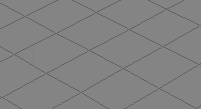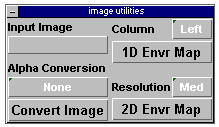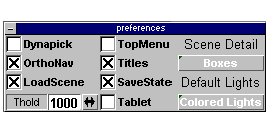
trueSpace2 In-Depth
|
We received the following note from Devin Knutscon:
|
||
We were admittedly curious, so we went to Caligari's web site to investigate. Once there, we found the following claims:
There is no doubt that truespace2 is a useful application. It offers tremendous graphical power and features that allow you to create some truly inspiring graphics. However, this power comes at a great cost: the user interface will absolutely confound experienced Windows users. You will quickly find yourself stumbling over the interface and struggling to understand its idiosyncracies. To be able to use truespace2 effectively, you have to forget that you have ever used a Windows application before. Last updated 13-Mar-1997 |

The first thing one notices about trueSpace2 is that the application is upside-down. The title bar, menu bar, and toolbar are placed at the bottom of the screen. If you have your Windows95 taskbar set to Auto-Hide, you will likely find yourself constantly triggering the taskbar, which then overlays the trueSpace2 menu bar. You have to move the cursor away from the taskbar, wait for it to hide, then, very carefully, try to click on the menu title without triggering the taskbar again. One does not have to examine the title bar very closely to notice some additional differences between it and the standard windows title bar. The trueSpace2 title bar is actually a condensation of the title bar, menu bar, and toolbar into a single apparent object. Everything is squished together, except the window management buttons (close, minimize, maximize); the latter are split between the left and right portions of the new title bar (not all are visible in this image). Further exploration of the interface reveals that the status bar, used to display context-specific help, in not placed at the bottom of the window as it would normally be located, but between the title bar and the toolbar. This placement makes it difficult to read the status information, since it is effectively camouflaged by its surrounding objects. trueSpace2 does provide the option of locating the title bar at the top of the window, but this option (labeled 'TopMenu') also moves the status bar to the top as well. |

These are the various toolbar buttons used in trueSpace2; we've grouped them together to conserve space (the buttons on the bottom row are normally located in the title bar). We would never have considered using a pastel color scheme before; now we know why. The soft colors make it difficult to distinguish among the many buttons. The shape of the image is muted by the color scheme, making it difficult to extract the shapes in the images. Here's a test: locate the Cut (actually 'Erase') and Copy buttons from the toolbar (answers at the bottom of this page). Despite the difficulties locating and interpreting the toolbar images, you better get used to it: whereas most applications use the toolbar as an additional means of accessing frequently used functions, in trueSpace2, it is the only way. The designers proclaim this as a feature of the interface: The interface is completely icon-driven ... no more searching through endless menus and submenus to find the features you need.We regard it as a severe hindrance. One of the benefits of a menu-driven application is that it groups the functions (hopefully) into logical groups. For many new users, this is the primary means of learning the application. One can quickly scan the items contained in each menu simply by dragging the cursor along the standard menu bar. The designers of trueSpace2, however, chose to nest the functions in the toolbar buttons, forcing the user to alternately open and close various function windows (more on closing windows later) until the desired function is eventually located. Rather than searching through menus, which have titles to describe them, the user must resort to searching through cryptic toolbars and sub-toolbars to find the needed function. An example of this problem became immediately apparent. The first task we attempted was to draw some 3D text on the screen. We examined each toolbar button, read the status line for each, and could not find a Text function. We opened the Help file, searched for "Text", and was instructed to simply hit the "Text" button. We then went back and examined the status message for each toolbar button again, in the event that we may have skipped it in our first pass. The second search was no more fruitful than the first. After some reflection, we hypothesized that perhaps Text is considered a Primitive object, so we clicked on the Primitives button (guess which button that is). We were then rewarded with a secondary panel containing an additional 15 toolbar buttons, one of which was the Text button. By virtue of trueSpace2's "easy-to-use" interface, it required 20 minutes and reference to the Help file to locate a basic function. |
 Speaking of adding text, when we finally found the text function, we lost the cursor. Eventually, as our random mouse movements returned the cursor to the toolbar area, it was visible again. The problem: the trueSpace2 drawing area has a medium gray background, and the text cursor has a medium gray background, one shade darker. This can be seen by close inspection of the image here, but is even less clear when one is working with a maximized window.
Speaking of adding text, when we finally found the text function, we lost the cursor. Eventually, as our random mouse movements returned the cursor to the toolbar area, it was visible again. The problem: the trueSpace2 drawing area has a medium gray background, and the text cursor has a medium gray background, one shade darker. This can be seen by close inspection of the image here, but is even less clear when one is working with a maximized window.
Of course, there might be a way to change the default color of the workspace, but we sure couldn't find it. |
 The toolbar is the main feature of the trueSpace2 interface, but it is also perhaps the most difficult aspect of the application to understand. Depending upon the button, the user may be required to left-click, right-click, or click-and-hold on the button. There is no apparent indication on the button to signify how it should be operated, and because of this omission, the user cannot anticipate what is required of him or her, nor what will happen as a result of a particular action.
The toolbar is the main feature of the trueSpace2 interface, but it is also perhaps the most difficult aspect of the application to understand. Depending upon the button, the user may be required to left-click, right-click, or click-and-hold on the button. There is no apparent indication on the button to signify how it should be operated, and because of this omission, the user cannot anticipate what is required of him or her, nor what will happen as a result of a particular action.
Most of the toolbar buttons will display a "Panel" (actually a modeless mini-dialog box that usually contains a number of additional toolbar-like buttons) in response to a left-click. Others, such as the "Deform Object" button shown here, will display a Panel upon a left-click, but will also display a sub-toolbar if the user holds the mouse button down for a short period of time. Others, such as the "Axes" button will toggle a change in the display when left-clicked, and some, like the "Toggle Grid Mode" will have no apparent effect when left-clicked, but will display a properties panel when right-clicked. The lack of consistency in the operation of the various buttons makes learning the application very difficult. |
 After the toolbar, "Panels" are the next most significant interface objects in trueSpace2. The Properties panel is shown at the right. All of the panels are modeless, meaning they remain on the screen until you specifically dismiss them (although this is not always true; selection of certain toolbar buttons will close the panels opened by certain other toolbar buttons).
After the toolbar, "Panels" are the next most significant interface objects in trueSpace2. The Properties panel is shown at the right. All of the panels are modeless, meaning they remain on the screen until you specifically dismiss them (although this is not always true; selection of certain toolbar buttons will close the panels opened by certain other toolbar buttons).
An alternative means, not described in the Help file, is to click on the system menu button in the upper left corner of the panel. The reason this is not described in the Help file is because the window title bars are optional, though why anyone would want to hide the only indication of what function they are currently using escapes us. |
 So confident were trueSpace2's designers of the intuitiveness of the application, they decided that command button labels were not needed. The rectangle, under the words "Input Image" is actually a command button. Clicking on it will cause a standard (really!) Windows file dialog box to be displayed. Upon selecting a file, the caption of the button will change from nothing to the name of the selected file. Unfortunately, if you really didn't want to assign a file, there's no way to cancel or otherwise Undo the selection. ("Who would ever need to do that?")
So confident were trueSpace2's designers of the intuitiveness of the application, they decided that command button labels were not needed. The rectangle, under the words "Input Image" is actually a command button. Clicking on it will cause a standard (really!) Windows file dialog box to be displayed. Upon selecting a file, the caption of the button will change from nothing to the name of the selected file. Unfortunately, if you really didn't want to assign a file, there's no way to cancel or otherwise Undo the selection. ("Who would ever need to do that?")
|
 Using standard Windows controls would have been too easy, on the programmer and on the user. This is the only reason we can come up with to explain the combo-command button used throughout trueSpace2. Click on one of these buttons, and a list of various settings is overlaid onto the button. Unlike standard combo-box controls, the user must hold the mouse button down to move through the list; releasing the button will select the item currently under the cursor.
Using standard Windows controls would have been too easy, on the programmer and on the user. This is the only reason we can come up with to explain the combo-command button used throughout trueSpace2. Click on one of these buttons, and a list of various settings is overlaid onto the button. Unlike standard combo-box controls, the user must hold the mouse button down to move through the list; releasing the button will select the item currently under the cursor.
To the experienced Windows user, this can be downright frustrating. Windows users typically click (and release) the down arrow of a combo-box, then scroll through the resultant list, and click again to make the selection and close the list. By creating their own control, trueSpace2's designers have required us to unlearn a well-ingrained habit, just so that we can interact with their program. |
 By eschewing standard controls, trueSpace increases the probability that the user will make an inadvertent selection. This particular panel uses the same pseudo-combo-command button as shown above, however, because the list is longer, and the window is positioned near the bottom of the screen (by default), the designer's opted to shift the list up, so that it can be displayed in its entirety. In so doing, as soon as the user clicks on the button, the selection is automatically changed, without any input from the user other than clicking on the button in the first place. The animation to the right shows the effect in response to a single click on the combo-command button.
By eschewing standard controls, trueSpace increases the probability that the user will make an inadvertent selection. This particular panel uses the same pseudo-combo-command button as shown above, however, because the list is longer, and the window is positioned near the bottom of the screen (by default), the designer's opted to shift the list up, so that it can be displayed in its entirety. In so doing, as soon as the user clicks on the button, the selection is automatically changed, without any input from the user other than clicking on the button in the first place. The animation to the right shows the effect in response to a single click on the combo-command button.
|
|
For example, to open the "Object Information" panel for a given object on the screen, the user must click on the object to select it, and then, right-click on the pointer toolbar button (we're not kidding). Additionally, to set the font for text on the screen, you must right-click on the Text button, rather than the text you want to modify. Unfortunately, you must specify the font before you create the text object; you cannot modify the font of an existing text object. The only direct manipulation going on here is the manipulation of potential customers into believing that this product is easy-to-use. |
Answers to the Toolbar Quiz:
|
| trueSpace2 is unquestionably a very powerful and feature-rich application that will allow its users to create stunning graphics and visual effects. We'll trust the reviews in such magazines as InfoWorld and PC Week when they say you cannot find more features at a better price than trueSpace. But there is no question that proficiency with the tool will require extensive practice, trial-and-error, and a stunning lack of familiarity with how Windows applications normally operate. This is a tool designed for full-time users who can afford the very significant investment in hands-on training it requires. |
© 1996-2000 Isys Information Architects Inc. All rights reserved.
Reproduction in whole or in part in any form or medium without express written permission is prohibited.
GP designpartners provide this mirror — for educational purposes only — as the interface hall of shame is no longer maintained or available at its original home, www.iarchitect.com [a domain apparently abandoned and taken over by a search spammer ...].
you can view this file in its original layout: truesp.htm.
please drop us a line if you happen to know anything about the whereabouts of brian c hayes of isys information architects, the author of this »interface hall of shame« [and fame].

 Because the panels are modeless, the user spends much of his or her time closing windows that are no longer needed. Unfortunately, the experienced Windows user will initially have some difficulty closing these panels, since the standard window management controls have been removed from the panel's title bar. According to the Help file, the panel may be closed by right-clicking on either a blank area on the panel (if one can be found), or on a button on the panel, then dragging the cursor outside of the panel's border. The effect, as shown here, is laughable. Releasing the right-button will close the panel.
Because the panels are modeless, the user spends much of his or her time closing windows that are no longer needed. Unfortunately, the experienced Windows user will initially have some difficulty closing these panels, since the standard window management controls have been removed from the panel's title bar. According to the Help file, the panel may be closed by right-clicking on either a blank area on the panel (if one can be found), or on a button on the panel, then dragging the cursor outside of the panel's border. The effect, as shown here, is laughable. Releasing the right-button will close the panel.
